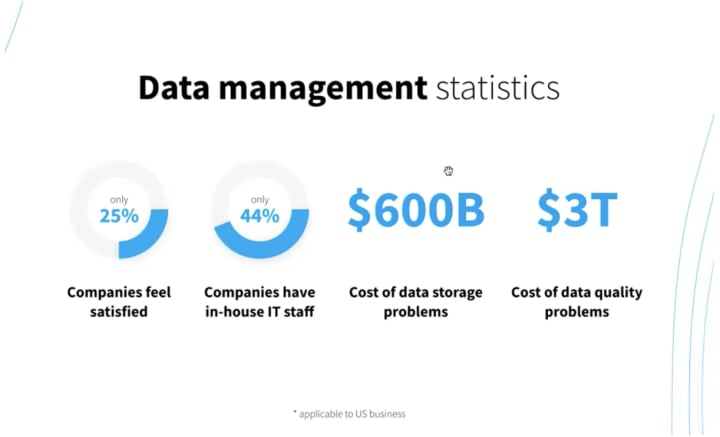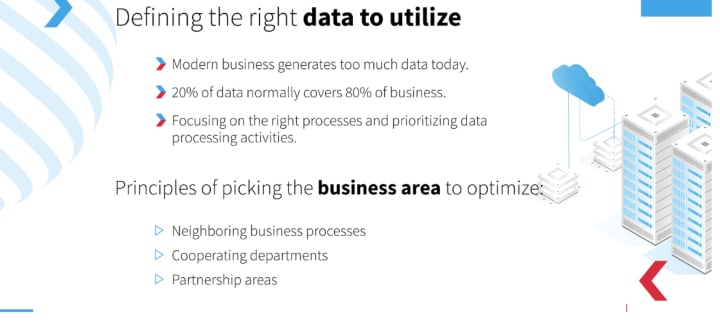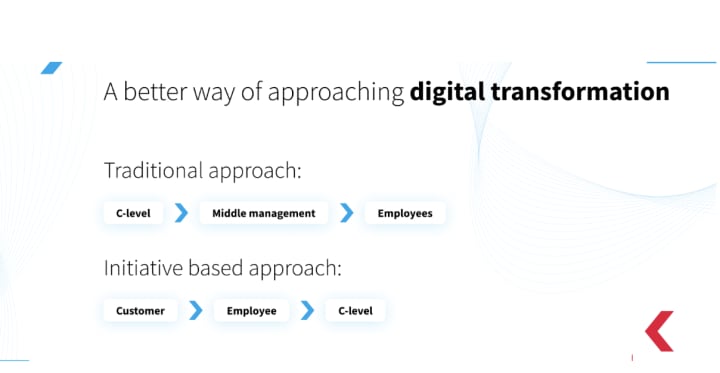Enterprise Data Management
Managing your Business’s Entire Data Lifeсycle
Hi, I am Eugene Rudenko, an AI Solutions Consultant with more than fifteen years of experience in business consulting for the software development industry.
I work at NIX, a global software engineering company with a head office in St. Petersburg, Florida. Our company has extensive experience in a variety of commercial and technological sectors. We've a leading R&D partner in East Europe since 1994, with 3000+ professionals worldwide. Together, we provide top-of-the-line solutions to tech businesses, SaaS providers, and international corporations, allowing them to expand their capabilities and contribute to market leadership.
I make an effort to keep up with technological developments and implement the most effective ones in the software development process. When I found myself in the area of Data Science, I discovered that this is where cutting-edge AI solutions are being adopted and improved for business problems. My expertise mainly involves the development of business automation and software products and business research and advising. As a result, I'd like to discuss the relevance of data management for businesses and how to manage the entire data lifecycle efficiently.
Why Is Data Management Important?

Data visibility, reliability, security, and scalability
Businesses spend a lot of time and money acquiring data, which is transferred back and forth between storage systems. Therefore, it's critical to get the most profit and value from the collected data. Data management ensures data meets specific criteria.
Let's start with visibility, which refers to the capacity to quickly and easily find needed data. It's also referred to as accessibility. Data labeling is one of the most straightforward ways to make your data more accessible. Whenever you have data labeled, it's easier to find the data, process it, or filter it. Visualization is also a key to the possibility of sharing data insights whenever you need to present your findings to someone.
The next point to consider is reliability. Being involved in data management, you are the one to decide where your data comes from, how it's processed, and how it's integrated with other available data. So, ensuring that your data is consistent, comes from a trustworthy source, and is appropriately formatted is what reliability is all about.
Next is security, which is one of the most crucial parts. Data loss is something that your company and its employees must be protected from. Many businesses are concerned about data breaches, particularly those that deal with personal, financial, and health information.
The final factor required for data is scalability. This allows you to implement and run repetitive processes without duplicate data and do the same data processing on multiple ends of your data pipelines by different departments or employees. Avoiding data duplications improves data consistency by reducing the risk of errors and misinformation during data processing.
Data Governance vs. Data Management
You don't have to put data governance and management in opposition to one another. Data governance is a specific method of data management applied in the context of organizations. Three principles characterize data governance.
First, it is essential to understand that data is a business asset, just like any other asset (financial, material, etc.) that is used to run a business. It necessitates the existence of the proper business vertical—complete with its own structure, hierarchy, and standards—and an understanding of how this structure should be addressed in the firm. It requires proper, responsible management. The chief data officer (CDO) usually carries out such a function. The new department does not exist as an appendix to the IT department. It is a separate corporate entity that does not primarily deal with technology. It exists at the edge of data science, and business demands and possibilities can be exploited and optimized using data.
Data quality refers to how well data is structured, how well it is optimized for storage and processing, and how well it is put together with data from other sources. These issues must be addressed in the context of business—for example, how relevant your data is to the business goals you're pursuing. So, the question is, does it store the data we require for our business to continue to evolve?
Coverage. This describes if we're collecting enough data to run our business and achieve our business goals.
Structure. Is the data well-structured in order to be processed in terms of business goals? For example, if we need to work with text data to process resumes, forms, applications, or medical documents, we need to make sure that these documents aren't merely saved as .pdf files or something else; they need to be available for processing and properly structured.
Data accuracy. This is about how reliable and complete your data is and whether or not we can use it to achieve our business objectives. For example, in the case of an online store, if we store the data of customers' purchases but not visits, it may not make sense. We can't generate vital business statistics and KPIs without complete data.
Defining the right data to utilize

Modern businesses generate much more data than they can process efficiently. A basic Pareto principle that can also be applied here is that about 20% of data powers typically 80% of the business. So, companies should prioritize processing the correct data instead of trying to get every piece of data utilized.
Let’s talk about a few principles for picking the proper business area and appropriate functions of business where optimization can be the most efficient. First, we have neighboring business processes. For example, if you have a business process involving several departments or company branches, you will be the first candidate to help with data issues such as data entry errors, duplication, and misunderstandings. In such a case, manual data processing should be minimized, and optimization would be required to ensure that the business runs smoothly.
Cooperation between departments in which one process is followed by another neighboring department, and then a chain of business processes is run by the federal department. A data flow in which one department shares information with another is vulnerable to errors.
It becomes even more critical when partnering with other businesses because each company has its own set of rules, data formats, and standards. When data from multiple companies are merged or shared, extra caution must be exercised to ensure that no problems arise. This is why there are so many actual integration products on the market, and they are in such high demand because whenever you integrate your business with another company or two products within each other, you will almost certainly run into issues, and that is where you should seek optimization.
A better way of approaching digital transformation

Now I'd like to emphasize the importance of comparing the typical approach to digital transformation with proper business optimization. Traditionally, a top manager would push an initiative to middle management, which would then identify an employee responsible for actually implementing it. Unfortunately, employees typically do not comprehend the need for these adjustments in this situation, and it may even meet the initiative controversially.
Instead, there is a different approach for data flow from bottom to top. In this approach, an employee who directly interacts with customers—whether they are product users or service consumers—is the one who knows how the company's product is perceived, what the feedback is, and what the user experience is. As a result, employees are the ones who interact with customers and have the most insight into how the product might be improved.
So it makes sense to encourage these employees and so-called initiatives from the bottom to the top. Those in charge of budgets and decision-making power can approve the necessary changes.
Every business comes to the point when it decides to run business optimization. Using one of the existing solutions or known methods, there is always the question of whether it is more reasonable to build such a solution or buy it. It needs to be considered that setting the right priorities is the most critical step here because different businesses exist at different stages and have other business purposes. For example, time to market is crucial for startups where the success of their product may be a matter of a few weeks and is not a crucial factor for existing businesses that want to improve their product by enhancing user experience. That’s why startups usually consider buying existing, ready-made solutions. However, such solutions generally have limitations like license limitations or functional limitations.
That’s why when businesses grow and overgrow out-of-the-box solutions, they start to build their own tool, their own product, to replace ready-made solutions that they used before.
About the Creator
Yevheniia Kryvenko
Skillful PR manager at NIX with a growth mindset and determination, looking for an opportunity in everything. Has a great experience in cooperation with technology experts, foreign media, and business associations.
Enjoyed the story? Support the Creator.
Subscribe for free to receive all their stories in your feed. You could also pledge your support or give them a one-off tip, letting them know you appreciate their work.






Comments
There are no comments for this story
Be the first to respond and start the conversation.